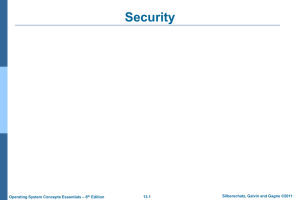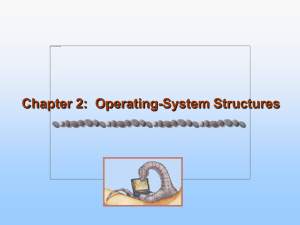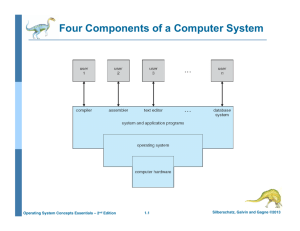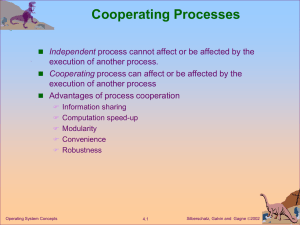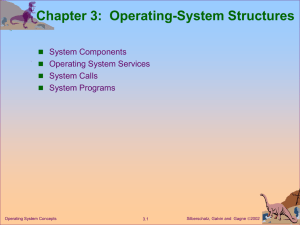Chapter 9
advertisement
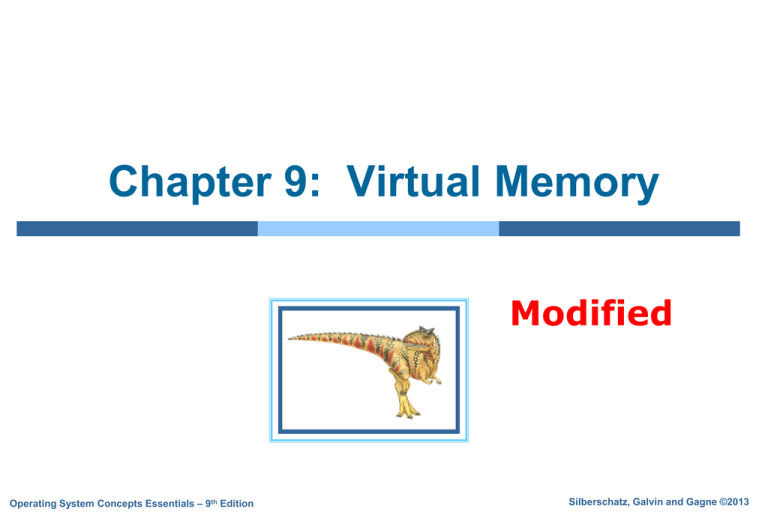
Chapter 9: Virtual Memory Modified Operating System Concepts Essentials – 9th Edition Silberschatz, Galvin and Gagne ©2013 Chapter 9: Virtual Memory Background Demand Paging Copy-on-Write Page Replacement Allocation of Frames Thrashing Memory-Mapped Files Other Considerations Operating-System Examples Operating System Concepts Essentials – 9th Edition 9.2 Silberschatz, Galvin and Gagne ©2013 Background Code needs to be in memory to execute, but entire program rarely used, not needed during all of execution e.g. Error code, unusual routines, large data structures Consider ability to execute partially-loaded program Program no longer constrained by limits of physical memory Program and programs can be larger than physical memory Operating System Concepts Essentials – 9th Edition 9.3 Silberschatz, Galvin and Gagne ©2013 Background Virtual memory – separation of user logical memory from physical memory Only part of the program needs to be in memory for execution Logical (virtual) address space can therefore be much larger than physical address space Allows address spaces to be shared by several processes Allows for more efficient process creation - fork More programs running concurrently- better CPU utilization Less I/O needed to load or swap processes Virtual memory can be implemented via: Demand paging Demand segmentation Operating System Concepts Essentials – 9th Edition 9.4 Silberschatz, Galvin and Gagne ©2013 Virtual Memory That is Larger Than Physical Memory Page table Operating System Concepts Essentials – 9th Edition 9.5 Silberschatz, Galvin and Gagne ©2013 Virtual Address Space Enables sparse address spaces with holes left for growth, dynamically linked libraries, etc System libraries shared via mapping into virtual address space Shared memory by mapping pages read-write into virtual address space Pages can be shared during fork(), speeding process creation Operating System Concepts Essentials – 9th Edition 9.6 Silberschatz, Galvin and Gagne ©2013 Shared Library Using Virtual Memory Operating System Concepts Essentials – 9th Edition 9.7 Silberschatz, Galvin and Gagne ©2013 Demand Paging Could bring entire process into memory at load time Or bring a page into memory only when it is needed Less I/O needed, no unnecessary I/O Less memory needed Faster response More users Page is needed reference to it invalid reference abort not-in-memory (page fault) bring to memory Lazy swapper – never swaps a page into memory unless page will be needed Swapper that deals with pages is a pager Operating System Concepts Essentials – 9th Edition 9.8 Silberschatz, Galvin and Gagne ©2013 Valid-Invalid Bit With each page table entry a valid–invalid bit is associated (v in-memory – memory resident, i not-in-memory) Initially valid–invalid bit is set to i on all entries Example of a page table snapshot: Frame # valid-invalid bit v v v v i …. i i page table During address translation, if valid–invalid bit in page table entry is I page fault Operating System Concepts Essentials – 9th Edition 9.9 Silberschatz, Galvin and Gagne ©2013 Page Table When Some Pages Are Not in Main Memory Operating System Concepts Essentials – 9th Edition 9.10 Silberschatz, Galvin and Gagne ©2013 Page Fault If there is a reference to a page marked as invalid, there is a trap to operating system - page fault 1. Operating system looks at info in PCB to decide: Invalid reference abort Just not in memory 2. Find/create empty frame 3. Swap page into frame via scheduled disk operation 4. Reset tables to indicate page now in memory Set validation bit = v 5. Restart the instruction that caused the page fault Operating System Concepts Essentials – 9th Edition 9.11 Silberschatz, Galvin and Gagne ©2013 Aspects of Demand Paging Start process with no pages in memory - Pure demand paging OS sets instruction pointer to first instruction of process, nonmemory-resident -> page fault Actually, a given instruction could access multiple pages -> multiple page faults Pain decreased because of locality of reference Hardware support needed for demand paging Page table with valid / invalid bit --- with TLB Secondary memory (swap device with swap space) Instruction restart – can be tricky Operating System Concepts Essentials – 9th Edition 9.12 Silberschatz, Galvin and Gagne ©2013 Instruction Restart Consider an instruction that could access several different locations block move – e.g. string copy auto increment/decrement location Restart the whole operation? What if source and destination overlap? Operating System Concepts Essentials – 9th Edition 9.13 Silberschatz, Galvin and Gagne ©2013 Steps in Handling a Page Fault Operating System Concepts Essentials – 9th Edition 9.14 Silberschatz, Galvin and Gagne ©2013 Performance of Demand Paging Stages in Demand Paging 1. Trap to the operating system 2. Save the user registers and process state 3. Determine that the interrupt was a page fault 4. Check that the page reference was legal and determine the location of the page on the disk 5. Issue a read from the disk to a free frame: 1. Wait in a queue for this device until the read request is serviced 2. Wait for the device seek and/or latency time 3. Begin the transfer of the page to a free frame Operating System Concepts Essentials – 9th Edition 9.15 Silberschatz, Galvin and Gagne ©2013 Performance of Demand Paging 6. While waiting, allocate the CPU to some other user 7. Receive an interrupt from the disk I/O subsystem (I/O completed) - page has been loaded into frame 8. Save the registers and process state for the other user 9. Determine that the interrupt was from the disk 10.Correct the page table and other tables to show page is now in memory 11.Wait for the CPU to be allocated to this process again 12.Restore the user registers, process state, and new page table, and then resume the interrupted instruction Operating System Concepts Essentials – 9th Edition 9.16 Silberschatz, Galvin and Gagne ©2013 Performance of Demand Paging (Cont.) Page miss rate = Page Fault Rate 0 p 1 if p = 0 no page faults if p = 1, every reference is a fault Effective Access Time (EAT) EAT = (1 – p) x memory access + p (page fault overhead + swap page out + swap page in + restart overhead ) Operating System Concepts Essentials – 9th Edition 9.17 Silberschatz, Galvin and Gagne ©2013 Demand Paging Example Memory access time = 200 nanoseconds Average page-fault service time = 8 milliseconds EAT = (1 – p) x 200 + p x 8,000,000 = 200 – p x 200 + p x 8,000,000 = 200 + p x 7,999,800 If one access out of 1,000 causes a page fault (p-.001), then EAT = 8.2 microseconds. This is a slowdown by a factor of 40!! If want performance degradation < 10 percent 220 > 200 + 7,999,800 x p 20 > 7,999,800 x p p < .0000025 < one page fault in every 400,000 memory accesses Operating System Concepts Essentials – 9th Edition 9.18 Silberschatz, Galvin and Gagne ©2013 Copy-on-Write Copy-on-Write (COW) allows both parent and child processes to initially share the same pages in memory If either process modifies a shared page, only then is the page copied COW allows more efficient process creation as only modified pages are copied In general, free pages are allocated from a pool of zero-fill-on-demand pages Why zero-out a page before allocating it? Operating System Concepts Essentials – 9th Edition 9.19 Silberschatz, Galvin and Gagne ©2013 Before Process 1 Modifies Page C Operating System Concepts Essentials – 9th Edition 9.20 Silberschatz, Galvin and Gagne ©2013 After Process 1 Modifies Page C Operating System Concepts Essentials – 9th Edition 9.21 Silberschatz, Galvin and Gagne ©2013 9.4 What Happens if There is no Free Frame? Used up by process pages Also in demand from the kernel, I/O buffers, etc How much to allocate to each? Page replacement – find some page in memory, but not really in use, page it out Performance – want an algorithm which will result in minimum number of page faults Same page may be brought into memory several times Operating System Concepts Essentials – 9th Edition 9.22 Silberschatz, Galvin and Gagne ©2013 9.4 Page Replacement As memory allocation increases, we need a good strategy for page replacement Use modifed (dirty) bit to reduce overhead of page transfers – only modified pages are written back to disk Operating System Concepts Essentials – 9th Edition 9.23 Silberschatz, Galvin and Gagne ©2013 Need For Page Replacement Operating System Concepts Essentials – 9th Edition 9.24 Silberschatz, Galvin and Gagne ©2013 Basic Page Replacement 1. Find the location of the desired page on disk 2. Find a free frame: - If there is a free frame, use it - If there is no free frame, use a page replacement algorithm to select a victim frame - Write victim frame to disk if dirty 3. Bring the desired page into the (newly) free frame; update the page and frame tables 4. Continue the process by restarting the instruction that caused the trap Operating System Concepts Essentials – 9th Edition 9.25 Silberschatz, Galvin and Gagne ©2013 Page Replacement Operating System Concepts Essentials – 9th Edition 9.26 Silberschatz, Galvin and Gagne ©2013 Page and Frame Replacement Algorithms Frame-allocation algorithm determines How many frames to give each process Page-replacement algorithm determines Which frames to replace Want lowest page-fault rate Evaluate algorithm by running it on a particular string of memory references (reference string) and computing the number of page faults on that string Reference string is just page numbers, not full addresses Repeated access to the same page does not cause a page fault In all our examples, the reference string is 7,0,1,2,0,3,0,4,2,3,0,3,0,3,2,1,2,0,1,7,0,1 Operating System Concepts Essentials – 9th Edition 9.27 Silberschatz, Galvin and Gagne ©2013 Graph of Page Faults Versus The Number of Frames Allocated Operating System Concepts Essentials – 9th Edition 9.28 Silberschatz, Galvin and Gagne ©2013 First-In-First-Out (FIFO) Algorithm Reference string: 7,0,1,2,0,3,0,4,2,3,0,3,0,3,2,1,2,0,1,7,0,1 3 frames (3 pages can be in memory at a time per process) 1 7 2 4 0 7 2 0 3 2 1 0 3 1 0 3 2 1 15 page faults Can vary by reference string: consider 1,2,3,4,1,2,5,1,2,3,4,5 Adding more frames can cause more page faults! Belady’s Anomaly How to track ages of pages? Just use a FIFO queue Operating System Concepts Essentials – 9th Edition 9.29 Silberschatz, Galvin and Gagne ©2013 FIFO Page Replacement Operating System Concepts Essentials – 9th Edition 9.30 Silberschatz, Galvin and Gagne ©2013 FIFO Illustrating Belady’s Anomaly Operating System Concepts Essentials – 9th Edition 9.31 Silberschatz, Galvin and Gagne ©2013 Optimal Algorithm Replace page that will not be used for longest period of time 9 page faults is optimal for the our running example as shown on the next slide How do you know this? Can’t read the future Used for measuring how well your algorithm performs - comparison Operating System Concepts Essentials – 9th Edition 9.32 Silberschatz, Galvin and Gagne ©2013 Optimal Page Replacement Operating System Concepts Essentials – 9th Edition 9.33 Silberschatz, Galvin and Gagne ©2013 Least Recently Used (LRU) Algorithm Use past knowledge rather than future Replace page that has not been used in the most amount of time Associate time of last use with each page 12 faults – better than FIFO but worse than OPT Generally good algorithm and frequently used But how to implement? Operating System Concepts Essentials – 9th Edition 9.34 Silberschatz, Galvin and Gagne ©2013 LRU Algorithm (Cont.) Counter implementation Every page entry has a counter field; every time page is referenced through this entry, copy the “clock” into the counter field When a page needs to be changed, look at the counter fields to find smallest value Search through table needed Stack implementation Keep a stack of page numbers in a double link form: Page referenced: move it to the top requires 6 pointers to be changed But each update more expensive No search for replacement LRU doesn’t suffer from Belady’s Anomaly Operating System Concepts Essentials – 9th Edition 9.35 Silberschatz, Galvin and Gagne ©2013 Use Of A Stack to Record The Most Recent Page References Operating System Concepts Essentials – 9th Edition 9.36 Silberschatz, Galvin and Gagne ©2013 LRU Approximation Algorithms LRU needs special hardware and still slow Reference bit With each page associate a bit, initially = 0 When page is referenced bit set to 1 Replace any with reference bit = 0 (if one exists) We do not know the order, however Usually keep queue of reference bit values sampled at intervals Shift right at interval 01010011 -> 00101001 LRU has smallest value Operating System Concepts Essentials – 9th Edition 9.37 Silberschatz, Galvin and Gagne ©2013 Counting Algorithms Keep a counter of the number of references that have been made to each page Not common LFU Algorithm: replaces page with smallest count MFU Algorithm: based on the argument that the page with the smallest count was probably just brought in and has yet to be used Operating System Concepts Essentials – 9th Edition 9.38 Silberschatz, Galvin and Gagne ©2013 Page-Buffering Algorithms Keep a pool of free frames, always Then frame available when needed, not found at fault time Read page into free frame and select victim to evict and add to free pool When convenient/efficient, evict victim Possibly, keep list of modified pages When backing store otherwise idle, write pages there and set to non-dirty Operating System Concepts Essentials – 9th Edition 9.39 Silberschatz, Galvin and Gagne ©2013 Allocation of Frames Each process needs minimum number of frames Example: IBM 370 – 6 pages to handle SS MOVE instruction: instruction is 6 bytes, might span 2 pages 2 pages to handle from 2 pages to handle to Maximum possible of course is total frames in the system Two major allocation schemes fixed allocation priority allocation Many variations Operating System Concepts Essentials – 9th Edition 9.40 Silberschatz, Galvin and Gagne ©2013 Fixed Allocation Equal allocation – For example, if there are 100 frames (after allocating frames for the OS) and 5 processes, give each process 20 frames Keep some as free frame buffer pool Proportional allocation – Allocate according to the size of process Dynamic as degree of multiprogramming, process sizes change Operating System Concepts Essentials – 9th Edition 9.41 Silberschatz, Galvin and Gagne ©2013 Priority Allocation Use a proportional allocation scheme using priorities rather than size If process Pi generates a page fault, select for replacement one of its frames select for replacement a frame from a process with lower priority number Operating System Concepts Essentials – 9th Edition 9.42 Silberschatz, Galvin and Gagne ©2013 Global vs. Local Allocation Global replacement – process selects a replacement frame from the set of all frames; one process can take a frame from another But then process execution time can vary greatly But greater throughput so more common Local replacement – each process selects from only its own set of allocated frames More consistent per-process performance But possibly underutilized memory Operating System Concepts Essentials – 9th Edition 9.43 Silberschatz, Galvin and Gagne ©2013 Thrashing If a process does not have “enough” pages, the page-fault rate is very high Page fault to get page Replace existing frame But quickly need replaced frame back This leads to: Low CPU utilization Operating system thinking that it needs to increase the degree of multiprogramming Another process added to the system Thrashing a process is busy swapping pages in and out Operating System Concepts Essentials – 9th Edition 9.44 Silberschatz, Galvin and Gagne ©2013 Thrashing (Cont.) Operating System Concepts Essentials – 9th Edition 9.45 Silberschatz, Galvin and Gagne ©2013 Demand Paging and Thrashing Why does demand paging work? Locality model Process migrates from one locality to another Localities may overlap Why does thrashing occur? size of locality > total memory size Limit effects by using local or priority page replacement Operating System Concepts Essentials – 9th Edition 9.46 Silberschatz, Galvin and Gagne ©2013 Locality In A Memory-Reference Pattern Operating System Concepts Essentials – 9th Edition 9.47 Silberschatz, Galvin and Gagne ©2013 Working-Set Model working-set window a fixed number of page references Example: 10,000 instructions WSSi (working set size of Process Pi) = number of pages referenced in the most recent (varies in time) if too small will not encompass entire locality if too large will encompass several localities if = will encompass entire program D = WSSi total demand frames if D > m Thrashing Policy if D > m, then suspend or swap out one of the processes Operating System Concepts Essentials – 9th Edition 9.48 Silberschatz, Galvin and Gagne ©2013 Working-set model Operating System Concepts Essentials – 9th Edition 9.49 Silberschatz, Galvin and Gagne ©2013 Keeping Track of the Working Set Approximate with interval timer + a reference bit Example: = 10,000 Timer interrupts after every 5000 time units Keep 2 page ref. history bits for each page Whenever a timer interrupts, copy and update these ref. history bits If one of the bits in memory = 1 page in working set Operating System Concepts Essentials – 9th Edition 9.50 Silberschatz, Galvin and Gagne ©2013 Page-Fault Frequency More direct approach than WSS Establish “acceptable” page-fault frequency rate and use local replacement policy If actual rate too low, process loses frame If actual rate too high, process gains frame Operating System Concepts Essentials – 9th Edition 9.51 Silberschatz, Galvin and Gagne ©2013 9.7 Memory-Mapped Files Memory-mapped file I/O allows file I/O to be treated as routine memory access by mapping a disk block to a page in memory A file is initially read using demand paging A page-sized portion of the file is read from the file system into a physical page Subsequent reads/writes to/from the file are treated as ordinary memory accesses Simplifies and speeds file access by driving file I/O through memory rather than read() and write() system calls Also allows several processes to map the same file allowing the pages in memory to be shared But when does written data make it to disk? Periodically and/or at file close() time For example, when the pager scans for dirty pages Operating System Concepts Essentials – 9th Edition 9.52 Silberschatz, Galvin and Gagne ©2013 Other Considerations -- Prepaging Prepaging To reduce the large number of page faults that occurs at process startup Prepage all or some of the pages a process will need, before they are referenced But if prepaged pages are unused, I/O and memory was wasted Operating System Concepts Essentials – 9th Edition 9.53 Silberschatz, Galvin and Gagne ©2013 Other Issues – Page Size Sometimes OS designers have a choice Especially if running on custom-built CPU Page size selection must take into consideration: Fragmentation Page table size I/O overhead Number of page faults Locality TLB size and effectiveness Always power of 2, usually in the range 212 (4,096 bytes) to 222 (4,194,304 bytes) On average, growing over time Operating System Concepts Essentials – 9th Edition 9.54 Silberschatz, Galvin and Gagne ©2013 Windows XP Uses demand paging with clustering. Clustering brings in pages surrounding the faulting page Processes are assigned working set minimum and working set maximum Working set minimum is the minimum number of pages the process is guaranteed to have in memory A process may be assigned as many pages up to its working set maximum When the amount of free memory in the system falls below a threshold, automatic working set trimming is performed to restore the amount of free memory Working set trimming removes pages from processes that have pages in excess of their working set minimum Operating System Concepts Essentials – 9th Edition 9.55 Silberschatz, Galvin and Gagne ©2013


